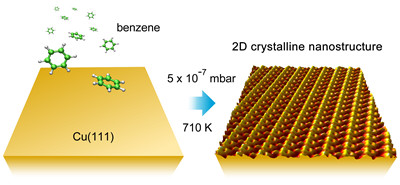The research group of Dr. ZHAO Aidi and Prof. WANG Bing from Hefei National Laboratory for Physical Sciences at Microscale has made new progress in the systhesis of 2D carbon-based nanostructure. The results has been published on the RSC journal Nanoscale (DOI: 10.1039/C4NR00017J).

Two-dimensional (2D) carbon-based nanostructures have attracted much attention because of their great potential in applications of quantum physics, information science, electronics and optoelectrons, and catalysis. However, currently most 2D carbon-based nanomaterials are derived from graphene and related materials. It is eagerly desired to discover and synthesis new 2D carbon-based nanostructures with various structures and novel properties. In this study, the researchers developed a new facile method to construct highly-ordered carbon-based 2D crystalline nanostructure by chemical vapor deposition (CVD) of benzene on Cu(111) in an ultrahigh vacuum (UHV) chamber. Low temperature scanning tunneling microscopy and spectroscopy (STM/STS) and X-ray photoelectron spectroscopy (XPS) study of the nanostructure combined with Density functional theory (DFT) calculation and simulation indicate that the 2D nanostructure has a native semiconductor character and may consist of polyphenylene chains interconnected by Cu adatoms. The nanostructure is also found to be a surprisingly excellent template for isolating and stabilizing magnetic atoms, serving as a potential playground for organic electronics and spintronic applications. This discovery provides research basis for further development of systhesis new 2D organic nanostructure with high-vacuum techniques.
The research was supported by fundings from NSFC, CAS, MOE and MOST of china.
(HFNL)